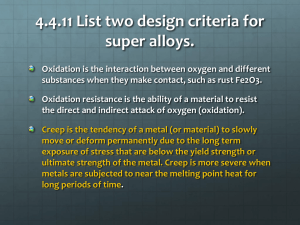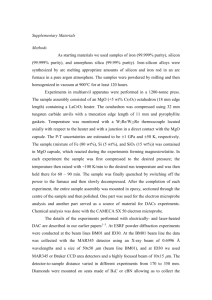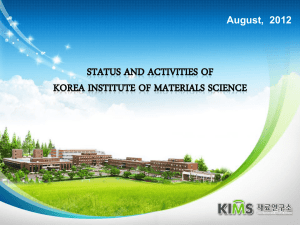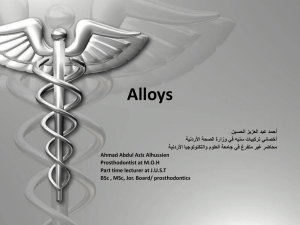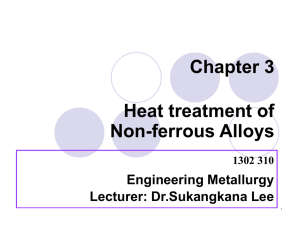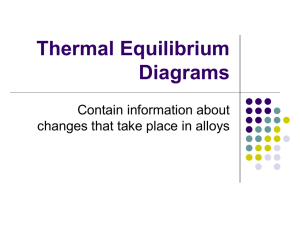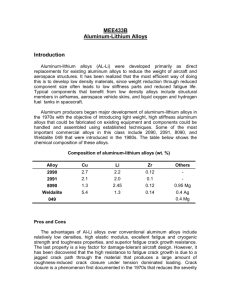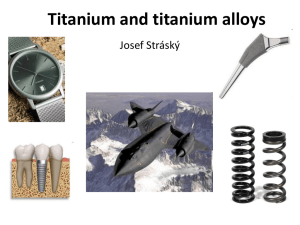Temperature dependence of microstructure of Al-Ag
advertisement
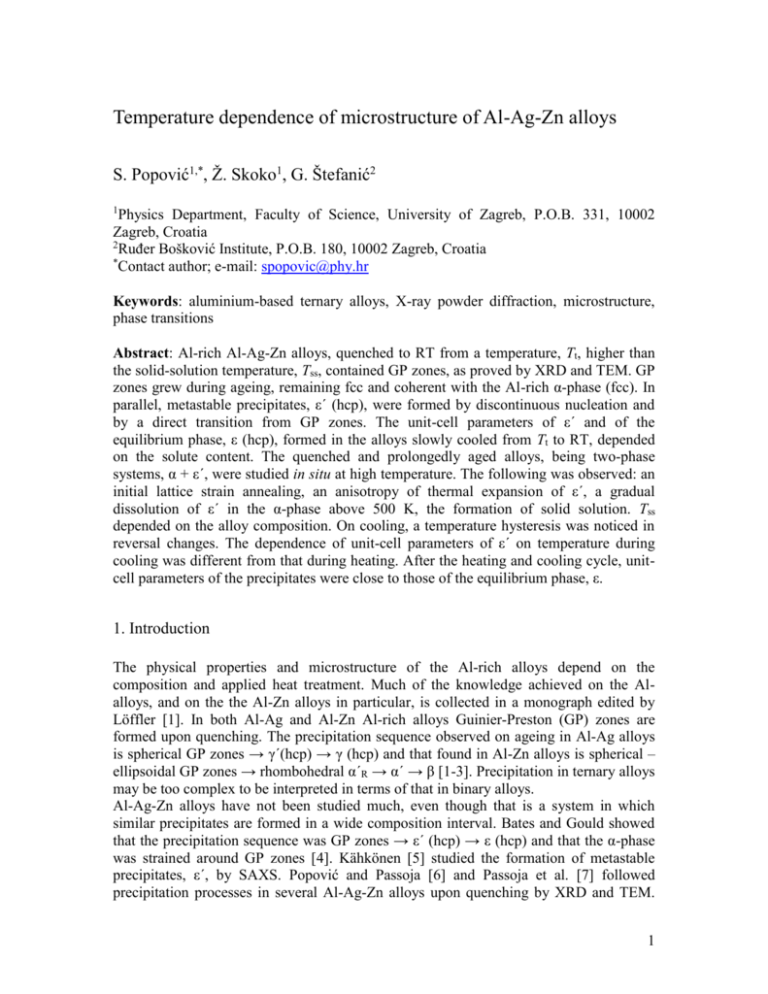
Temperature dependence of microstructure of Al-Ag-Zn alloys
S. Popović1,*, Ž. Skoko1, G. Štefanić2
1
Physics Department, Faculty of Science, University of Zagreb, P.O.B. 331, 10002
Zagreb, Croatia
2
Ruđer Bošković Institute, P.O.B. 180, 10002 Zagreb, Croatia
*
Contact author; e-mail: spopovic@phy.hr
Keywords: aluminium-based ternary alloys, X-ray powder diffraction, microstructure,
phase transitions
Abstract: Al-rich Al-Ag-Zn alloys, quenched to RT from a temperature, Tt, higher than
the solid-solution temperature, Tss, contained GP zones, as proved by XRD and TEM. GP
zones grew during ageing, remaining fcc and coherent with the Al-rich α-phase (fcc). In
parallel, metastable precipitates, ε´ (hcp), were formed by discontinuous nucleation and
by a direct transition from GP zones. The unit-cell parameters of ε´ and of the
equilibrium phase, ε (hcp), formed in the alloys slowly cooled from Tt to RT, depended
on the solute content. The quenched and prolongedly aged alloys, being two-phase
systems, α + ε´, were studied in situ at high temperature. The following was observed: an
initial lattice strain annealing, an anisotropy of thermal expansion of ε´, a gradual
dissolution of ε´ in the α-phase above 500 K, the formation of solid solution. Tss
depended on the alloy composition. On cooling, a temperature hysteresis was noticed in
reversal changes. The dependence of unit-cell parameters of ε´ on temperature during
cooling was different from that during heating. After the heating and cooling cycle, unitcell parameters of the precipitates were close to those of the equilibrium phase, ε.
1. Introduction
The physical properties and microstructure of the Al-rich alloys depend on the
composition and applied heat treatment. Much of the knowledge achieved on the Alalloys, and on the the Al-Zn alloys in particular, is collected in a monograph edited by
Löffler [1]. In both Al-Ag and Al-Zn Al-rich alloys Guinier-Preston (GP) zones are
formed upon quenching. The precipitation sequence observed on ageing in Al-Ag alloys
is spherical GP zones → γ´(hcp) → γ (hcp) and that found in Al-Zn alloys is spherical –
ellipsoidal GP zones → rhombohedral α´R → α´ → β [1-3]. Precipitation in ternary alloys
may be too complex to be interpreted in terms of that in binary alloys.
Al-Ag-Zn alloys have not been studied much, even though that is a system in which
similar precipitates are formed in a wide composition interval. Bates and Gould showed
that the precipitation sequence was GP zones → ε´ (hcp) → ε (hcp) and that the α-phase
was strained around GP zones [4]. Kähkönen [5] studied the formation of metastable
precipitates, ε´, by SAXS. Popović and Passoja [6] and Passoja et al. [7] followed
precipitation processes in several Al-Ag-Zn alloys upon quenching by XRD and TEM.
1
Lyon et al. [8] studied anomalous SAXS in Al-Ag-Zn alloys with comparison to Al-Zn
alloys. The present work is an extension of the previous studies [6,7], with the aim to
check the influence of a prolonged ageing of the quenched alloys on microstructure.
Also, the microstructure of the same alloys was followed by in situ XRD from RT to Tt
and back to RT, with comparison to that in the slowly cooled alloys.
2. Experimental
The alloys, prepared from elements of purity 5N, had an electron to atom ratio of 2.9
(table 1). The chosen Ag to Zn ratios might promote a certain stoichiometry of
precipitates, e.g. Al2AgZn or AlAgZn for alloy 3. The melted alloys were cast into copper
moulds and homogenized at Tt = 820 K. Small amounts of powdered alloys, wrapped in a
thin perforated Al foil, were treated at Tt, quenched in water at RT (293 K) and
immediately aged at Ta = 420 K. Also, powdered alloys were slowly furnace cooled to
RT over a week.
XRD patterns were recorded by a Philips diffractometer (proportional counter
monochromatized CuKα radiation, high-temperature attachment). The method for
minimization of systematic errors in unit-cell parameters a(α), a(GPZ), a(ε´, ε) and c(ε´,
ε) was described previously [6, 9]. For the α-phase, diffraction lines at highest Bragg
angles were utilized, while diffraction lines of precipitates appeared only at low/medium
Bragg angles, that influencing the accuracy of obtained values. Samples for TEM were
thermally treated in the same way as those for XRD.
The alloys that had been quenched from Tt to RT, aged at Ta for 50 days and then aged
for 38 years at RT, were studied in situ from RT to Tt and back to RT. A platinum strip
(in fact, a Pt alloy) served as a sample holder and a heater; diffraction lines of Pt were
used to calibrate the angular scale, utilizing its thermal expansion coefficient [10(2) x 10-6
/ K, measured by the same diffractometer].
Table 1. Composition of alloys and unit-cell parameter a(α) at RT of the slowly-cooled (α-phase in
equilibrium with precipitates ε) and as-quenched (α-phase containing GP zones) alloys at RT; the
measured unit-cell parameter of pure Al was 4.0492(1) Å at RT.
Alloy
Ag/at%
Zn/at%
Ag/Zn
Slowly-cooled
As-quenched
alloys
alloys
a(/)) / Å
a(/GPZ) / Å
1
4.44
1.11
4.00
4.0491(1)
4.0478(2)
2
4.00
2.00
2.00
4.0488(1)
4.0467(2)
3
3.33
3.33
1.00
4.0483(1)
4.0455(1)
4
2.50
5.00
0.50
4.0476(2)
4.0440(2)
5
1.43
7.15
0.20
4.0463(2)
4.0428(2)
2
3. Results and discussion
3.1 Slowly-cooled and quenched-aged alloys
The unit-cell parameter a(α) for the slowly cooled and as-quenched alloys are given in
table 1. a(α) decreased with the solute content, this being mainly influenced by Zn, as its
atomic radius is smaller than that of Al. A fraction of Zn remained solved in the slowly
cooled alloys. The unit-cell parameters of the equilibrium phase, ε (hcp), formed in the
slowly-cooled alloys, are given in table 2. These parameters decreased as the solute (Zn)
content increased. If extrapolated to 5 at% solute (i.e. to zero at% Zn), a(ε) and c(ε) were
close to the parameters of the γ-phase in Al-Ag alloys [1]. For alloy 3, a(ε) was almost
equal to the spacing dα110.
Table 2 . Unit-cell parameters of the ε-phase in slowly-cooled alloys and of the ε´-phase of alloys aged at
Ta after quenching, measured at RT.
Alloy
a()/Å
c()/Å
c()/a()
a(´)/Å
c(´)/Å
c(´)/a(´)
1
2.875(1)
4.562(1)
1.587
2.867(2)
4.557(2)
1.589
2
2.872(1)
4.553(1)
1.585
2.867(2)
4.545(2)
1.585
3
2.862(1)
4.526(1)
1.581
2.860(2)
4.510(2)
1.577
4
2.854(1)
4.501(1)
1.577
2.854(2)
4.474(3)
1.568
5
2.835(1)
4.450(1)
1.570
2.839(2)
4.412(3)
1.554
The quenched and aged (at Ta) alloys showed the precipitation sequence GP zones (fcc)
→ ε´ (hcp) → ε (hcp). GP zones and initial precipitates, ε´, are shown in figure 1. A line
of zero contrast through the GP zones indicated strained lattice around the zones. For
alloys with Ag/Zn > 1 GP zones were spheres; for alloys with Ag/Zn ≤ 1 GP zones were
also cubes and ellipsoids. GP zones exhibited broad XRD lines; an example is shown in
figure 2. GP zones diffraction lines sharpened with ageing due to their growth, from 3 or
4 to 6 nm for alloys 1 and 2 or to 8 to 9 nm for alloys 3, 4 and 5; these values were
obtained from XRD broadening and by TEM. The misfit [a(GPZ)-a(α)] / a(α) in the asquenched alloys changed from - 0.4 % for alloy 1 and to - 2 % for alloy 5 due to the
increased Zn content in the zones. During ageing, the misfit decreased due to a diffusion
of Zn away from the zones.
The metastable phase, ε´, is analogous to γ´ in Al-Ag alloys. The orientation relationship
between ε´ or ε platelets and the α-phase was: ε´, ε {001}||α{111}; ε´, ε [110]||α[110].
Diffraction lines of the α-phase split in two components on ageing, the high angle
component corresponded to the as-quenched alloy, and the low-angle component to the
slowly-cooled alloy. The former component (contained mainly GP zones) transformed to
the latter (having ε´ precipitates) on ageing. The separation between the components was
small (≈ 0.3°at 2 Θ ≈ 138°). That effect was interpreted as the discontinuous precipitation
3
of ε´. Similar effect was observed in Al-Cu [10] and Al-Zn [2] alloys (where the
separation increased with the Zn content).
Figure 1. GP zones and initial precipitates ε´ in as-quenched alloy 4
Figure 2. α200 and GP zones 200 diffraction lines of alloy 3, aged at T a for 8 hourss after quenching
4
The alloys 1 and 2 showed rather sharp ε´ diffraction lines 100, 002 and 101 after 2 days
of ageing. As ageing proceeded other ε´ diffraction lines appeared not changing their
positions. The unit-cell parameters of ε´ are given in table 2; it was found that a(ε) > a(ε´)
> dα110, c(ε) > c(ε´). For alloy 3, ε´ diffraction lines 100 and 200 were rather sharp, but
those with l ≠ 0 consisted of a sharp component and a broad one. That effect was
attributed to ε´ precipitates of two different sizes with similar unit-cell parameters given
in table 2. If followed: c(ε) > c(ε´); a(ε) ≈ a(ε´) ≈ dα110, this meaning a partial coherence
between the α and ε´-phases. Diffraction lines of ε´ in alloy 3 did not move as ageing
proceeded. The alloys 4 and 5 showed rather sharp ε´ diffraction lines at an initial ageing.
After a prolonged ageing, ε´ diffraction lines consisted of a sharp component and a broad
one, that effect being more pronounced for alloy 5 than for alloy 4. For the broad
component dε´100 ≈ dε100; for the sharp one d ε ¢100 » 3 2 d α100 . The sharp component moved
to the broad one on ageing, the latter did not move, but sharpened. After a prolonged
ageing, a(ε) ≈ a(ε´) < dα110, c(ε) > c(ε´) (table 2). The sharp component of ε´ diffraction
lines for alloys 3, 4 and 5 corresponded to the discontinuously nucleated ε´, while the
broad component resulted from a direct transition of GP zones into ε´. After ageing at
620 K and slow cooling to RT, these alloys showed only sharp diffraction lines of
precipitates, close to those of ε.
3.2 In situ XRD study of quenched and aged alloys at high temperature
As mentioned above, the microstructure of the quenched and aged (at Ta) alloys was
different from that of the slowly-cooled alloys. Crystal lattice of the α-phase was strained
around the ε´ platelets, that had very variable sizes. Diffraction patterns of the alloys that
had been prolongedly stored at RT, remained rather unchanged, except for small
sharpening of diffraction lines. In experiments with these alloys at high temperature a
special attention was paid to alloys 3, 4, and 5. Parts of XRD patterns of the alloy 4 at
selected temperatures are shown in figure 3. As the temperature of the alloys increased
above RT, a slight sharpening of diffraction lines of both α- and ε´-phases was observed
due to strain annealing. At the same time, a gradual shift of diffraction lines took place
due to thermal expansion. Thermal expansion coefficient of ε´ was slightly smaller along
the a-axis a) = 23(3)than along the c-axisc) = 26(3)10-6 /K, measured in
the interval from RT to 500 K. Thermal expansion of the α-phase was similar to that of ε´
along the a-axis. Above ≈ 500 K a gradual dissolution of ε´ in the α-phase took place,
manifesting in an enhanced decrease of ε´ diffraction intensities. At the same time, the
shift of ε´ diffraction lines toward smaller Bragg angles was accelerated. The solution of
Zn, from the ε´ precipitates, in the α-phase compensated or even reversed the shift of its
diffraction lines due to thermal expansion. The solid-solution temperature, Tss, was
estimated from the extrapolation of ε´ diffraction intensities to zero. Tss depended on the
alloy composition, amounting ≈ 720, 700 and 680 K for alloys 3, 4 and 5, resp. The
dissolution of ε´ was followed by crystal grain coarsening of the α-phase.
In the cooling run, the alloys exhibited a temperature hysteresis in reversal changes. The
precipitation started at a temperature lower for 10 to 20 K than that at which precipitates
dissolved on heating. The precipitation of ε´ on cooling caused fragmentation of α-phase
grains. The dependence of the unit-cell parameters of ε´ on temperature during cooling
was little different from that during heating. After a completion of the heating and
5
Figure 3. Characteristic parts of XRD patterns of the alloy 4 at selected temperatures
cooling cycle, the unit-cell parameters of the precipitates were very close to those of the
equilibrium phase, ε. Diffraction lines of the α-phase were slightly shifted toward smaller
Bragg angles, in comparison to their position before heating; that may mean a smaller
fraction of Zn remained solved in the α-phase. Diffraction lines of precipitates formed in
alloys 3, 4 and 5, after a completion of the heating and cooling cycle, did not show
composite profiles any more.
References
1. Löffler, H., 1995, Structure and Structure Development in Al-Zn Alloys (Berlin:
Akademie Verlag).
2. Popović, S. & Gržeta, B., 1999, Croatica Chemica Acta 72, 621.
3. Skoko, Ž. & Popović, S., 2006, Fizika A, 15, 61.
4. Bates, S. R. & Gould, W. R., 1971, Advances in X-ray Analysis, 14, 146.
5. Kähkönen, H. A., 1971, J. Appl. Cryst., 4, 396.
6. Popović, S. & Passoja, D. E., 1971, J. Appl. Cryst., 4, 427.
7. Passoja, D. E., Popović, S. & Barrand, P., 1974, Met. Trans., 5, 715.
8. Lyon, O, Hoyt, J. J., Pro, R., Davis, B. E. C., Clark, B., Fontaine, de D. &
Simon, J. P.,1985, J. Appl. Cryst., 18, 480.
9. Popović, S., 1985, Cryst. Res. Technol., 20, 552.
10. Popović, S., Passoja, D. E. & Barrand, P., 1970, Fizika, 2, 231.
6
